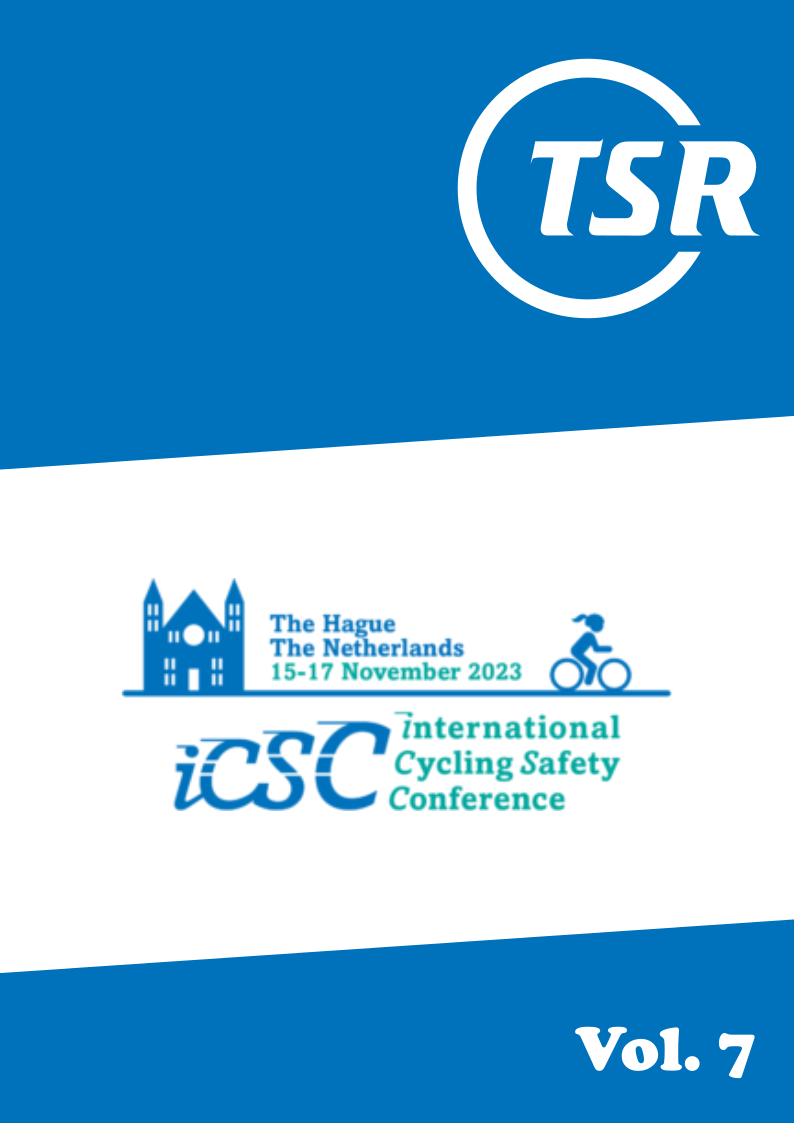Assessing the safety of international examples of bicycle streets to identify important design elements—an expert judgement
DOI:
https://doi.org/10.55329/fzue5335Keywords:
cycling infrastructure, expert judgementAbstract
The two most common types of cycling infrastructure are separated bicycle tracks and bicycle lanes. Several studies have been carried out to examine their impact on cycling safety. A relatively new type of cycling infrastructure, which is increasingly being implemented, is the bicycle street, defined as a street where bicycle traffic is prioritised and where motorised vehicles are limited in terms of volume and speed. Since bicycle streets are developed recently, the literature about their safety is scarce. Therefore, in order to provide directions for further research to the safety of bicycle streets, the present study aims to identify which design elements of bicycle streets are important to assess their safety, based on expert judgement. The expert judgement data were collected from 49 cycling safety professionals, divided over ten groups, during a workshop about the safety of bicycle streets during the 11th International Cycling Safety Conference 2023 in the Hague. The groups of cycling safety professionals categorised nine international examples of bicycle streets over three piles: ‘Safest’, ‘In between’, and ‘Least safe’. They also provided arguments about why they put a bicycle street on a specific pile. These arguments are used to identify important design elements that impact the safety of bicycle streets and are compared to existing literature. The results showed that expert judgements are considerably similar across the example bicycle streets and their design elements. The most important design elements to assess the safety are: width of the street, design to prioritise cyclists, road markings and parking. The literature shows that for some elements, general road safety knowledge exists, but that for most design elements no studies exist that examine their relation to the safety of bicycle streets in particular.
Downloads
References
ADFC Dresden, (2022), 'Vorfahrt auf #RadrouteOst! [Priority on #BicycleRouteEast!]', Twitter.
Andriesse, R. (2016), 'Fietsstraten binnen de bebouwde kom: Inventarisatierapport [Bicycle streets within the built-up area: Inventory report]', Goudappel Coffeng.
Andriesse, R., O. van Boggelen (2016), 'Discussienotitie fietsstraten binnen de kom [Discussion memo on bicycle streets within the city limits]', CROW-Fietsberaad, Notities.
Baert, W., I. Caers, M. de Jong (2021), 'Rapport fietsstraten en fietszones [Report on bicycle streets and bicycle zones]', Fietsberaad Vlaanderen.
Berghoefer, F. L., M. Vollrath (2022), 'Cyclists' perception of cycling infrastructure—A Repertory Grid approach', Transportation Research Part F: Traffic Psychology and Behaviour, 87, 249–263. DOI: https://doi.org/10.1016/j.trf.2022.04.012
Blanc, B., M. Figliozzi (2016), 'Modeling the impacts of facility type, trip characteristics, and trip stressors on cyclists’ comfort levels utilizing crowdsourced data', Transportation Research Record, 2587(1), 100–108. DOI: https://doi.org/10.3141/2587-12
Broach, J., J. Dill, J. Gliebe (2012), 'Where do cyclists ride? A route choice model developed with revealed preference GPS data', Transportation Research Part A: Policy and Practice, 46(10), 1730–1740. DOI: https://doi.org/10.1016/j.tra.2012.07.005
Bruno, M. (2020), 'The challenge of the bicycle street: Applying collaborative governance processes while protecting user centered innovations', Transportation Research Interdisciplinary Perspectives, 7, 100209. DOI: https://doi.org/10.1016/j.trip.2020.100209
Bunn, F., T. Collier, C. Frost, K. Ker, R. Steinbach, I. Roberts, R. Wentz (2003), 'Area-wide traffic calming for preventing traffic related injuries', Cochrane Database of Systematic Reviews, (1) CD003110. DOI: https://doi.org/10.1002/14651858.CD003110
Cicchino, J. B. (2019), 'Real-world effects of rear cross-traffic alert on police-reported backing crashes', Accident Analysis & Prevention, 123, 350–355. DOI: https://doi.org/10.1016/j.aap.2018.11.007
City of Palo Alto, (2021), 'Neighborhood Traffic Safety & Bicycle Boulevard Projects', City of Palo Alto, [Photograph].
Clayden, A., K. Mckoy, A. Wild (2006), 'Improving residential liveability in the UK: Home zones and alternative approaches', Journal of Urban Design, 11(1), 55–71. DOI: https://doi.org/10.1080/13574800500490307
CROW, (2021), 'ASVV 2021', CROW, Aanbevelingen voor verkeersvoorzieningen binnen de bebouwde kom.
CROW-Fietsberaad, (2021), 'Evaluatie Discussienotitie Fietsstraten [Evaluation of discussion memo on bicycle streets]', CROW-Fietsberaad, Fietsberaadpublicatie 32.
Delbressine, R. R. H. L. (2013), 'The traffic safety of bicycle streets in the Netherlands', TU Delft, Master thesis.
DiGioia, J., K. E. Watkins, Y. Xu, M. Rodgers, R. Guensler (2017), 'Safety impacts of bicycle infrastructure: A critical review', Journal of Safety Research, 61, 105–119. DOI: https://doi.org/10.1016/j.jsr.2017.02.015
Fyhri, A., F. Sagberg, T. Bjørnskau, O. Johansson (2020), 'Sykkelpilot: Sykkelgate med begrenset biltrafikk i Porsgrunn [Cycle pilot study: Effect of bike street with limited car traffic in Porsgrunn]', Institute of Transport Economics, TØI-rapport 1791/2020.
Goldenbeld, C., I. N. L. G. van Schagen (1997), 'Video-evaluatie `fietsstraat' Utrecht [Video evaluation of the "bicycle street" in Utrecht]', SWOV, R-97-28.
Google Maps, (2022), '1 Rue des Dahlias, Luxembourg', Google Maps.
Greibe, P. (2003), 'Accident prediction models for urban roads', Accident Analysis & Prevention, 35(2), 273–285. DOI: https://doi.org/10.1016/S0001-4575(02)00005-2
Hagemeister, C., L. Kropp (2019), 'The door of a parking car being opened is a risk. No kerb-side parking is the key feature for perceived safety of on-road cycling facilities', Transportation Research Part F: Traffic Psychology and Behaviour, 66, 357–367. DOI: https://doi.org/10.1016/j.trf.2019.08.007
Hørup, K. (2020), 'Cykelgade i Odense', Trafiktanker, Photograph.
Jänsch, M., D. Otte, H. Johannsen (2015), 'Investigation of bicycle accidents involving collisions with the opening door of parking vehicles and demands for a suitable driver assistance system', International Research Council on the Biomechanics of Injury (IRCOBI), Lyon, France, 9–11 September.
Johnson, M., S. Newstead, J. Oxley, J. Charlton (2013), 'Cyclists and open vehicle doors: Crash characteristics and risk factors', Safety Science, 59, 135–140. DOI: https://doi.org/10.1016/j.ssci.2013.04.010
Jörgensen, P. (2020), 'Shared speed for safe transportation and sustainable cities—A study from a cyclist perspective on how traffic design can promote shared speed and the acceptance of mixed traffic', Chalmers University of Technology, Master Theses.
JYPS, (2022), 'Jyväskylän ensimmäisen pyöräkadun avajaiset Yrjönkadulla keskiviikkona 9.11.2022 klo 13–16 [The opening of Jyväskylä's first bicycle street on Yrjönkatu on Wednesday, November 9, 2022, 13–16]', JYPS.
Kalmthout, (2019), 'Fietsstraat Leopoldstraat [Bike street Leopoldstraat]', Kalmthout municipality.
And C-M, L., A. K-H (2003), 'Is Kentlands better than Radburn? The American Garden City and the new urbanist paradigms', Journal of the American Planning Association, 69(1), 50–71. DOI: https://doi.org/10.1080/01944360308976293
Leffler, B. (2022), 'Oderberger Straße: Von der Sackgasse zur Fahrradstrasse [Oderberger Straße: From dead end to bicycle street]', Entwicklungsstadt Berlin.
Ligtermoet, D. (2006), 'Fietsstraten, het modieuze voorbij [Bicycle streets, beyond the trendy]', Fietsverkeer.
Minikel, E. (2012), 'Cyclist safety on bicycle boulevards and parallel arterial routes in Berkeley, California', Accident Analysis & Prevention, 45, 241–247. DOI: https://doi.org/10.1016/j.aap.2011.07.009
Nabavi Niaki, M., T. Uijtdewilligen, S. E. Gebhard, W. A. M. Weijermars, J. W. H. van Petegem, W. J. R. Louwerse (2023), 'Veiligheid van fietsstraten: Literatuurstudie, beschouwing richtlijnen en ideeën voor onderzoek [Safety of bicycle streets: Literature review, consideration of guidelines and ideas for research]', SWOV, R-2023-14.
Odijk, M. J. M. (2023), 'Analysis of cyclists’ safety on “bicycle streets” and other facilities in four large Dutch municipalities: A crash and conflict study', PhD thesis, University of Twente, The Netherlands, Master.
Pai, C.-W. (2011), 'Overtaking, rear-end, and door crashes involving bicycles: An empirical investigation', Accident Analysis & Prevention, 43(3), 1228–1235. DOI: https://doi.org/10.1016/j.aap.2011.01.004
Porojkow, I., S. Lißner (2024), 'Friend or foe? A spatial approach to overlay bicycle and scooter trajectories', European Transport Research Review, 16, 32. DOI: https://doi.org/10.1186/s12544-024-00657-x
Pucher, J., R. Buehler (2008), 'Making cycling irresistible: Lessons from the Netherlands, Denmark and Germany', Transport Reviews, 28(4), 495–528. DOI: https://doi.org/10.1080/01441640701806612
Rivera Olsson, S., E. Elldér (2023), 'Are bicycle streets cyclist-friendly? Micro-environmental factors for improving perceived safety when cycling in mixed traffic', Accident Analysis & Prevention, 184, 107007. DOI: https://doi.org/10.1016/j.aap.2023.107007
Schaefer, J. S., M. A. Figliozzi, A. Unnikrishnan (2022), 'Evaluation of posted speed limit reductions on urban roads with a high percentage of cyclists', Transportation Research Record, 2676(6), 685–695. DOI: https://doi.org/10.1177/03611981221076115
Schimek, P. (2018), 'Bike lanes next to on-street parallel parking', Accident Analysis & Prevention, 120, 74–82. DOI: https://doi.org/10.1016/j.aap.2018.08.002
Sicherheitsdepartement Stadt Zürich, (2019), 'Städte sprechen sich für die Einführung von Velostrassen aus [Cities advocate for the introduction of bicycle streets]', Sicherheitsdepartement Stadt Zürich.
Šucha, M., E. Drimlová, K. Recka, N. Haworth, K. Karlsen, A. Fyhri, P. Wallgren, P. Silverans, F. Slootmans (2023), 'E-scooter riders and pedestrians: Attitudes and interactions in five countries', Heliyon, 9(4), 15449. DOI: https://doi.org/10.1016/j.heliyon.2023.e15449
SWOV, (2018), 'Sustainable Safety 3rd edition: The advanced vision for 2018-2030. Principles for design and organization of a casualty-free road traffic system', SWOV.
Teschke, K., M. A. Harris, C. C. O. Reynolds, M. Winters, S. Babul, M. Chipman, M. D. Cusimano, J. R. Brubacher, G. Hunte, S. M. Friedman, M. Monro, H. Shen, L. Vernich, P. A. Cripton (2012), 'Route infrastructure and the risk of injuries to bicyclists: a case-crossover study', American Journal of Public Health, 102(12), 2336–2343. DOI: https://doi.org/10.2105/AJPH.2012.300762
van 't Woud, E. (2018), 'Verkeerstheorie zakt weg, wat weet jij over fietsstraat en groene streep? [Traffic theory is falling apart, what do you know about bicycle streets and green lines?]', NOS Nieuws.
van Boggelen, O., R. Hulshof (2019), 'Fietsberaadnotitie: Aanbevelingen fietsstraten binnen de kom [Bicycle council note: Recommendations for bicycle streets within the city limits]', CROW-Fietsberaad.
Vandenbulcke, G., I. Thomas, L. I. Panis (2014), 'Predicting cycling accident risk in Brussels: A spatial case-control approach', Accident Analysis & Prevention, 62, 341–357. DOI: https://doi.org/10.1016/j.aap.2013.07.001
van Petegem, J. W. H., P. Schepers, G. J. Wijlhuizen (2021), 'The safety of physically separated cycle tracks compared to marked cycle lanes and mixed traffic conditions in Amsterdam', European Journal of Transport and Infrastructure Research, 21(3), 19–37. DOI: https://doi.org/10.18757/EJTIR.2021.21.3.5283
VanZerr, M. (2010), 'Resident perceptions of bicycle boulevards: A Portland, Oregon case study', Transportation Research Board 89th Annual Meeting, Washington, USA, 10–14 January.
Ville de Luxembourg, (2024), 'Cycling infrastructure', Ville de Luxembourg.
von Stülpnagel, R., R. Hologa, N. Riach (2022), 'Cars overtaking cyclists on different urban road types—Expectations about passing safety are not aligned with observed passing distances', Transportation Research Part F: Traffic Psychology and Behaviour, 89, 334–346. DOI: https://doi.org/10.1016/j.trf.2022.07.005
von Stülpnagel, R., R. Petinaud, C. Lißner (2022), 'Crash risk and subjective risk perception during urban cycling: Accounting for cycling volume', Accident Analysis & Prevention, 164, 106470. DOI: https://doi.org/10.1016/j.aap.2021.106470
Vriens, B. (2018), 'Het fietspad als sportveld: Een kwalitatief onderzoek naar de ervaringen van wielrenners over veiligheid op het fietspad en welke factoren zij als essentieel ervaren voor een veilige fietsomgeving [The cycle path as a sports field: A qualitative study on cyclists' experiences regarding safety on the cycle path and the factors they consider essential for a safe cycling environment]', PhD thesis, Utrecht University, The Netherlands.
Waagmeester, J. A. (2005), ' Fietsstratenplan Zwolle [Bicycle streets plan Zwolle]', Goudappel Coffeng, Beleidsdocumenten.
Wright, R. P. (2004), 'Mapping cognitions to better understand attitudinal and behavioral responses in appraisal research', Journal of Organizational Behavior, 25(3), 339–374. DOI: https://doi.org/10.1002/job.245
Published
How to Cite
Issue
Section
Categories
License
Copyright (c) 2024 Teun Uijtdewilligen, Gert Jan Wijlhuizen, Matin Nabavi Niaki

This work is licensed under a Creative Commons Attribution 4.0 International License.










